Design of Miniaturized Antipodal Vivaldi Antennas for Wideband Microwave Imaging of the Head
Abstract
1. Introduction
2. Principles and Techniques of Designing Vivaldi Antennas
3. Proposed Antenna 1
3.1. Design Evolution
3.1.1. Stage 1 (Conventional Antipodal Vivaldi Design)
3.1.2. Stage 2 (Addition of Corrugations)
3.1.3. Stage 3 (Addition of Feed Slot)
3.1.4. Stage 4 (Addition of Superstrates)
3.1.5. Stage 5 (Reduction of the Width of the Superstrates)
3.2. Performance Analysis
3.3. Parametric Analysis
3.4. Fabrication and Measurement
4. Proposed Antenna 2
4.1. Design Features
4.2. Performance Analysis
4.3. Parametric Analysis
4.4. Fabrication and Measurement
5. Comparison
6. Conclusions
Author Contributions
Funding
Acknowledgments
Conflicts of Interest
References
- Zu, H.; Wu, B.; Yang, P.; Li, W.; Liu, J. Wideband and High-Gain Wearable Antenna Array with Specific Absorption Rate Suppression. Electronics 2021, 10, 2056. [Google Scholar] [CrossRef]
- Al-Gburi, A.J.A.; Ibrahim, I.M.; Zakaria, Z.; Abdulhameed, M.K.; Saeidi, T. Enhancing gain for UWB antennas using FSS: A systematic review. Mathematics 2021, 9, 3301. [Google Scholar] [CrossRef]
- Hasan, M.; Faruque, M.R.I.; Islam, M.T.I. Dual band metamaterial antenna for LTE/bluetooth/WiMAX system. Sci. Rep. 2018, 8, 1240. [Google Scholar] [CrossRef] [PubMed]
- Hasan, M.; Faruque, M.R.I.; Islam, M.T. Thin-layer dielectric and left-handed metamaterial stacked compact triband antenna for 2 GHz to 4 GHz wireless networks. J. Electron. Mater. 2019, 48, 3979–3990. [Google Scholar] [CrossRef]
- Hasan, M.M.; Rahman, M.; Faruque, M.R.I.; Islam, M.T.; Khandaker, M.U. Electrically compact SRR-loaded metamaterial inspired quad band antenna for bluetooth/WiFi/WLAN/WiMAX system. Electronics 2019, 8, 790. [Google Scholar] [CrossRef]
- Ahmed, A.; Kumari, V.; Sheoran, G. Metamaterial surface and modified Vivaldi antenna to tune gain of microwave imaging instrument. Meas. Sci. Technol. 2020, 32, 035901. [Google Scholar] [CrossRef]
- Tan, G.-N.; Yang, X.-X.; Lu, Z.-L.; Jiang, X.-S. Metamaterial loaded vivaldi antenna with high gain and equal beamwidths at KA band. Microw. Opt. Technol. Lett. 2016, 58, 2337–2341. [Google Scholar] [CrossRef]
- Bhaskar, M.; Johari, E.; Akhter, Z.; Akhtar, M.J. Gain enhancement of the Vivaldi antenna with band notch characteristics using zero-index metamaterial. Microw. Opt. Technol. Lett. 2015, 58, 233–238. [Google Scholar] [CrossRef]
- Sun, M.; Chen, Z.N.; Qing, X. Gain enhancement of antipodal tapered slot antenna using zero-index metamaterial. In Proceedings of the 2012 IEEE Asia-Pacific Conference on Antennas and Propagation, Singapore, 27–29 August 2012. [Google Scholar]
- Joula, M.; Rafiei, V.; Karamzadeh, S. High gain UWB bow-tie antenna design for ground penetrating radar application. Microw. Opt. Technol. Lett. 2018, 60, 2425–2429. [Google Scholar]
- Chi, P.-L.; Waterhouse, R.; Itoh, T. Antenna miniaturization using slow wave enhancement factor from loaded transmission line models. IEEE Trans. Antennas Propag. 2010, 59, 48–57. [Google Scholar] [CrossRef]
- Abbosh, A. Miniaturization of planar ultrawideband antenna via corrugation. IEEE Antennas Wirel. Propag. Lett. 2008, 7, 685–688. [Google Scholar] [CrossRef]
- Qing, X.; Chen, Z.N.; Chia, M.Y.W. Dual elliptically tapered antipodal slot antenna loaded by curved terminations for ultrawideband applications. Radio Sci. 2006, 41, 1–14. [Google Scholar] [CrossRef]
- Kildal, P.-S. Artificially soft and hard surfaces in electromagnetics. IEEE Trans. Antennas Propag. 1990, 38, 1537–1544. [Google Scholar] [CrossRef]
- Bai, J.; Shi, S.; Prather, D.W. Modified compact antipodal Vivaldi antenna for 4–50-GHz UWB application. IEEE Trans. Microw. Theory Tech. 2011, 59, 1051–1057. [Google Scholar] [CrossRef]
- Wang, Z.; Zhang, H. Improvements in a high gain UWB antenna with corrugated edges. Prog. Electromagn. Res. 2009, 6, 159–166. [Google Scholar] [CrossRef][Green Version]
- Mohammed, B.J.; Abbosh, A.M.; Bialkowski, M.E. Design of tapered slot antenna operating in coupling liquid for ultrawideband microwave imaging systems. In Proceedings of the 2011 IEEE International Symposium on Antennas and Propagation (APSURSI), Spokane, WA, USA, 3–8 July 2011. [Google Scholar]
- Beada’a, J.M.; Abbosh, A.M.; Ireland, D.; Bialkowski, M.E. Wideband antenna for microwave imaging of brain. In Proceedings of the 2011 Seventh International Conference on Intelligent Sensors, Sensor Networks and Information Processing (ISSNIP), Adelaide, SA, Australia, 6–9 December 2011. [Google Scholar]
- Bourqui, J.; Okoniewski, M.; Fear, E.C. Balanced antipodal Vivaldi antenna with dielectric director for near-field microwave imaging. IEEE Trans. Antennas Propag. 2010, 58, 2318–2326. [Google Scholar] [CrossRef]
- Lazaro, A.; Villarino, R.; Girbau, D. Design of tapered slot Vivaldi antenna for UWB breast cancer detection. Microw. Opt. Technol. Lett. 2011, 53, 639–643. [Google Scholar] [CrossRef]
- Gibson, P. The vivaldi aerial. In Proceedings of the 1979 9th European Microwave Conference, Brighton, UK, 17–20 September 1979. [Google Scholar]
- Wang, S.; Chen, X.; Parini, C. Analysis of ultra wideband antipodal Vivaldi antenna design. In Proceedings of the 2007 Loughborough Antennas and Propagation Conference, Loughborough, UK, 2–3 April 2007. [Google Scholar]
- Abbosh, A.M. Miniaturized microstrip-fed tapered-slot antenna with ultrawideband performance. IEEE Antennas Wirel. Propag. Lett. 2009, 8, 690–692. [Google Scholar] [CrossRef]
- Gazit, E. Improved design of the Vivaldi antenna. In Proceedings of the IEE Proceedings H (Microwaves, Antennas and Propagation). IET Digit. Libr. 1988, 135, 89–92. [Google Scholar]
- Fallahpour, M.; Zoughi, R. Antenna miniaturization techniques: A review of topology-and material-based methods. IEEE Antennas Propag. Mag. 2017, 60, 38–50. [Google Scholar] [CrossRef]
- Kula, J.S.; Psychoudakis, D.; Liao, W.-J.; Chen, C.-C.; Volakis, J.L.; Halloran, J.W. Patch-antenna miniaturization using recently available ceramic substrates. IEEE Antennas Propag. Mag. 2006, 48, 13–20. [Google Scholar] [CrossRef]
- Lee, B.; Harackiewicz, F. Miniature microstrip antenna with a partially filled high-permittivity substrate. IEEE Trans. Antennas Propag. 2002, 50, 1160–1162. [Google Scholar]
- Milligan, T.A. Modern Antenna Design; John Wiley & Sons: Hoboken, NJ, USA, 2005. [Google Scholar]
- Maci, S.; Leoncini, M.; Neto, A.; Tiberio, R.; Toccafondi, A. Diffraction at artificially soft and hard edges by using incremental theory of diffraction. In Proceedings of the IEEE Antennas and Propagation Society International Symposium and URSI National Radio Science Meeting, Seattle, WA, USA, 20–24 June 1994. [Google Scholar]
- Fei, P.; Jiao, Y.-C.; Hu, W.; Zhang, F.-S. A miniaturized antipodal Vivaldi antenna with improved radiation characteristics. IEEE Antennas Wirel. Propag. Lett. 2011, 10, 127–130. [Google Scholar]
- Sugawara, S.; Maita, Y.; Adachi, K.; Mori, K.; Mizuno, K. A mm-wave tapered slot antenna with improved radiation pattern. In Proceedings of the 1997 IEEE MTT-S International Microwave Symposium Digest, Denver, CO, USA, 8–13 June 1997. [Google Scholar]
- Sugawara, S.; Maita, Y.; Adachi, K.; Mori, K.; Mizuno, K. Characteristics of a mm-wave tapered slot antenna with corrugated edges. In Proceedings of the 1998 IEEE MTT-S International Microwave Symposium Digest (Cat. No. 98CH36192), Baltimore, MD, USA, 7–12 June 1998. [Google Scholar]
- Nassar, I.T.; Weller, T.M. A novel method for improving antipodal Vivaldi antenna performance. IEEE Trans. Antennas Propag. 2015, 63, 3321–3324. [Google Scholar] [CrossRef]
- Wang, P.; Zhang, H.; Wen, G.; Sun, Y. Design of modified 6–18 GHz balanced antipodal Vivaldi antenna. Prog. Electromagn. Res. C 2012, 25, 271–285. [Google Scholar] [CrossRef]
- Parveen, F.; Wahid, P. Microwave Head Imaging System for Detection of Blood Clots inside the Brain. In Proceedings of the 2021 IEEE International Symposium on Antennas and Propagation and USNC-URSI Radio Science Meeting (APS/URSI), Singapore, 4–10 December 2021. [Google Scholar]
- Gupta, S.; Kshirsagar, P.; Mukherjee, B. A Low-Profile Multilayer Cylindrical Segment Fractal Dielectric Resonator Antenna: Usage for wideband applications. IEEE Antennas Propag. Mag. 2019, 61, 55–63. [Google Scholar] [CrossRef]
- Chen, L.; Wang, C.; Li, H.; Lan, S. A miniaturized antipodal vivaldi antenna for microwave imaging. In Proceedings of the 2017 International Symposium on Antennas and Propagation (ISAP), Phuket, Thailand, 30 October–2 November 2017. [Google Scholar]
- Aldhaeebi, M.A.; Elshafiey, I. Development of UWB Vivaldi antenna for microwave imaging. In Proceedings of the 2013 Saudi International Electronics, Communications and Photonics Conference, Riyadh, Saudi Arabia, 27–30 April 2013. [Google Scholar]
- Salleh, A.; Yang, C.C.; Singh, M.S.J.; Islam, M.T. Development of antipodal Vivaldi antenna for microwave brain stroke imaging system. Int. J. Eng. Technol. 2019, 8, 162–168. [Google Scholar]
- Chen, L.; Zhong, H.; Zhang, S.; Xia, L.; Zong, H.; Lan, S.A. Resistance Loaded Vivaldi Antenna for Microwave Imaging. In Proceedings of the 2018 International Symposium on Antennas and Propagation (ISAP), Busan, Korea, 23–26 October 2018. [Google Scholar]
- Dey, U.; Singhal, A. Design of antipodal Vivaldi antenna in matching medium for microwave medical imaging. Int. J. Eng. Res. Technol. (IJERT) 2014, 3, 1236–1239. [Google Scholar]
- Mohammed, B.; Abbosh, A.; Ireland, D. Directive wideband antenna for microwave imaging system for brain stroke detection. In Proceedings of the 2012 Asia Pacific Microwave Conference Proceedings, Kaohsiung, Taiwan, 4–7 December 2012. [Google Scholar]
- Wang, M.; Crocco, L.; Cavagnaro, M. Antipodal Vivaldi Antenna with Ceramic Cone Lens for Biomedical Microwave Imaging Systems. In Proceedings of the 2021 15th European Conference on Antennas and Propagation (EuCAP), Dusseldorf, Germany, 22–26 March 2021. [Google Scholar]

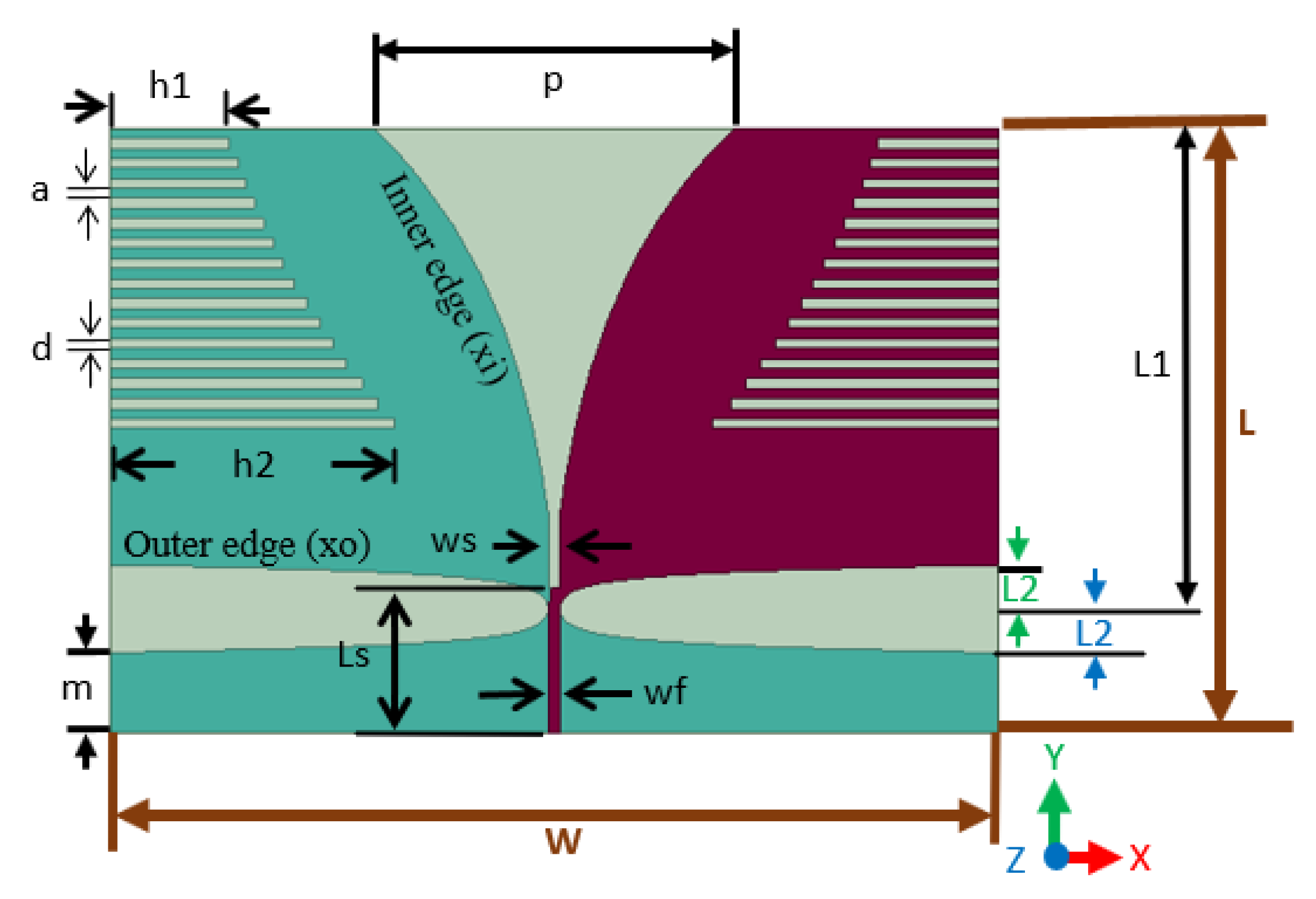
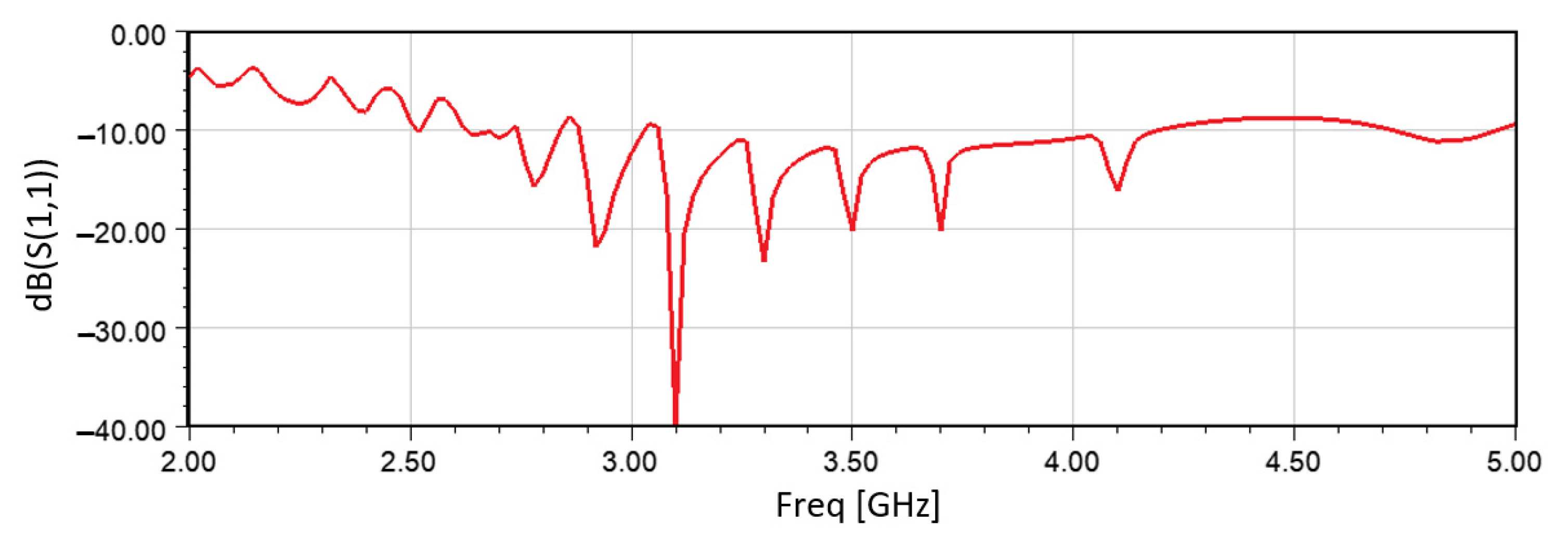
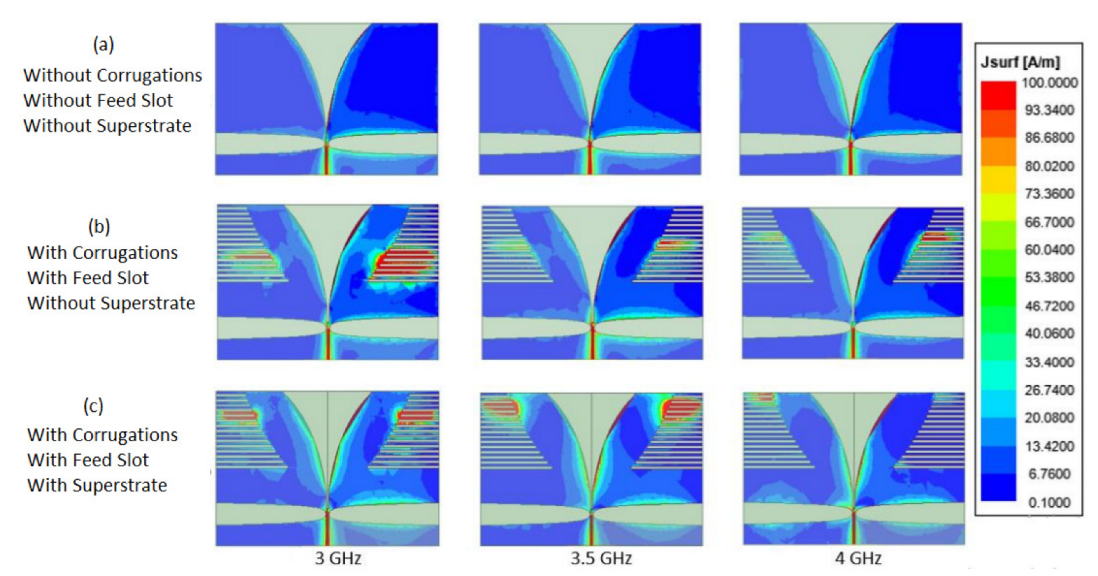
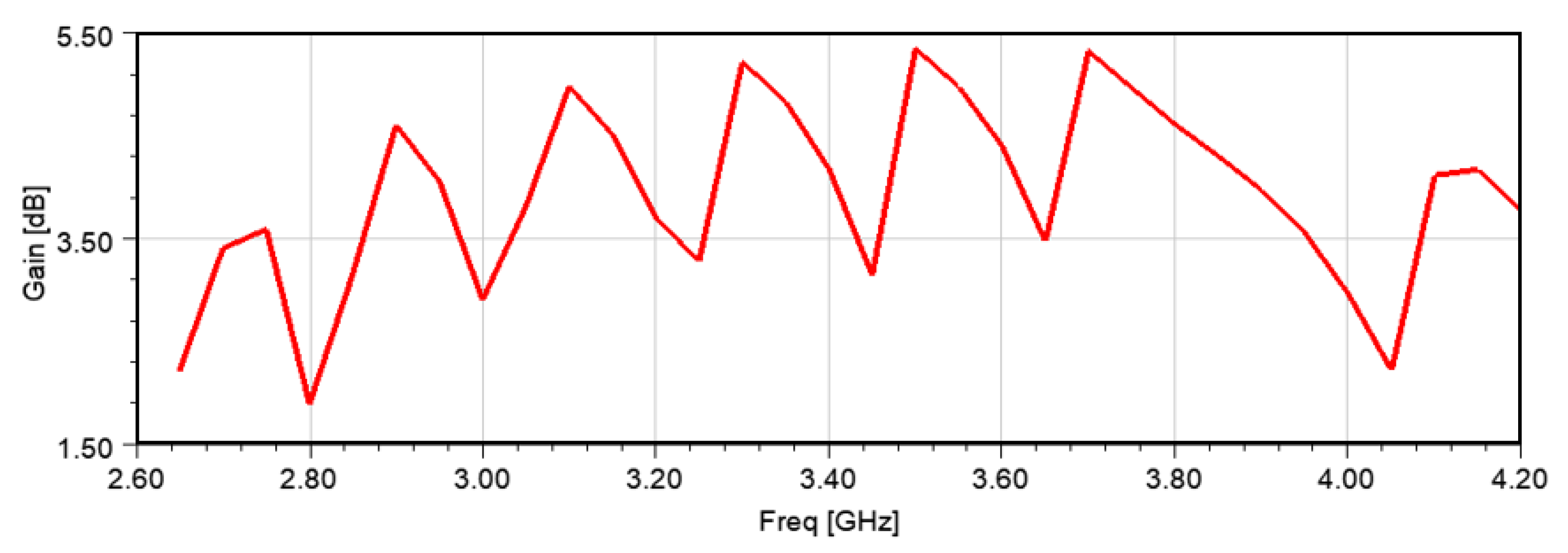
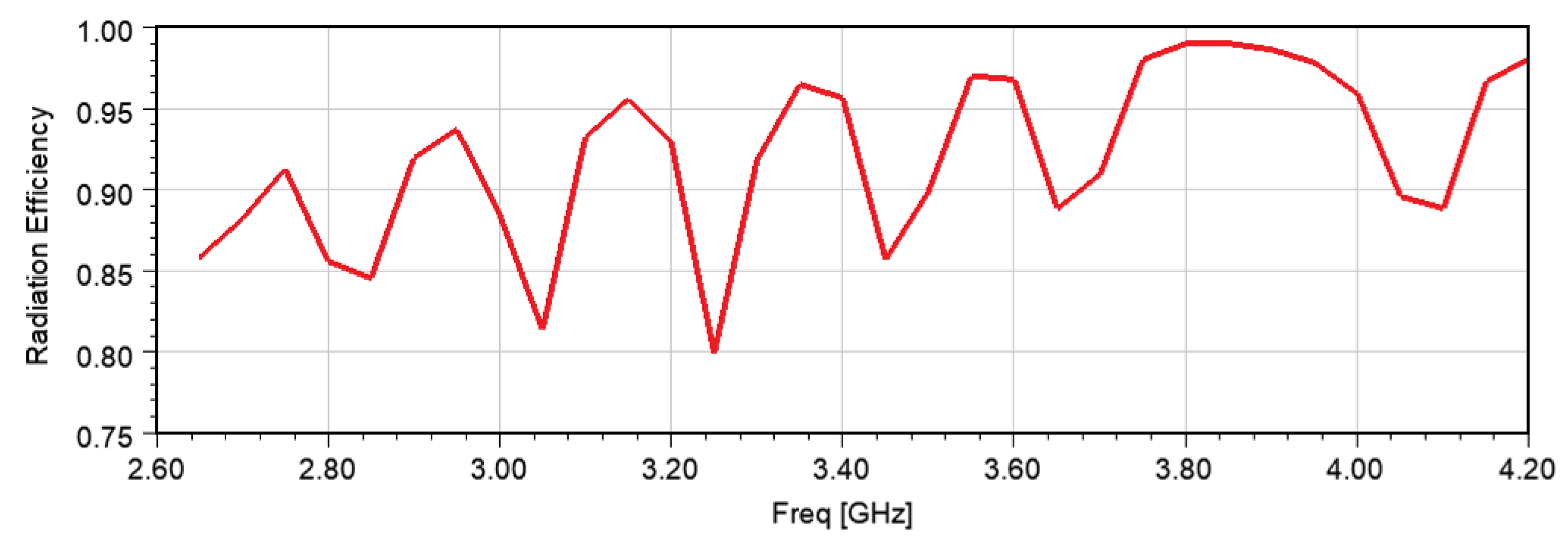

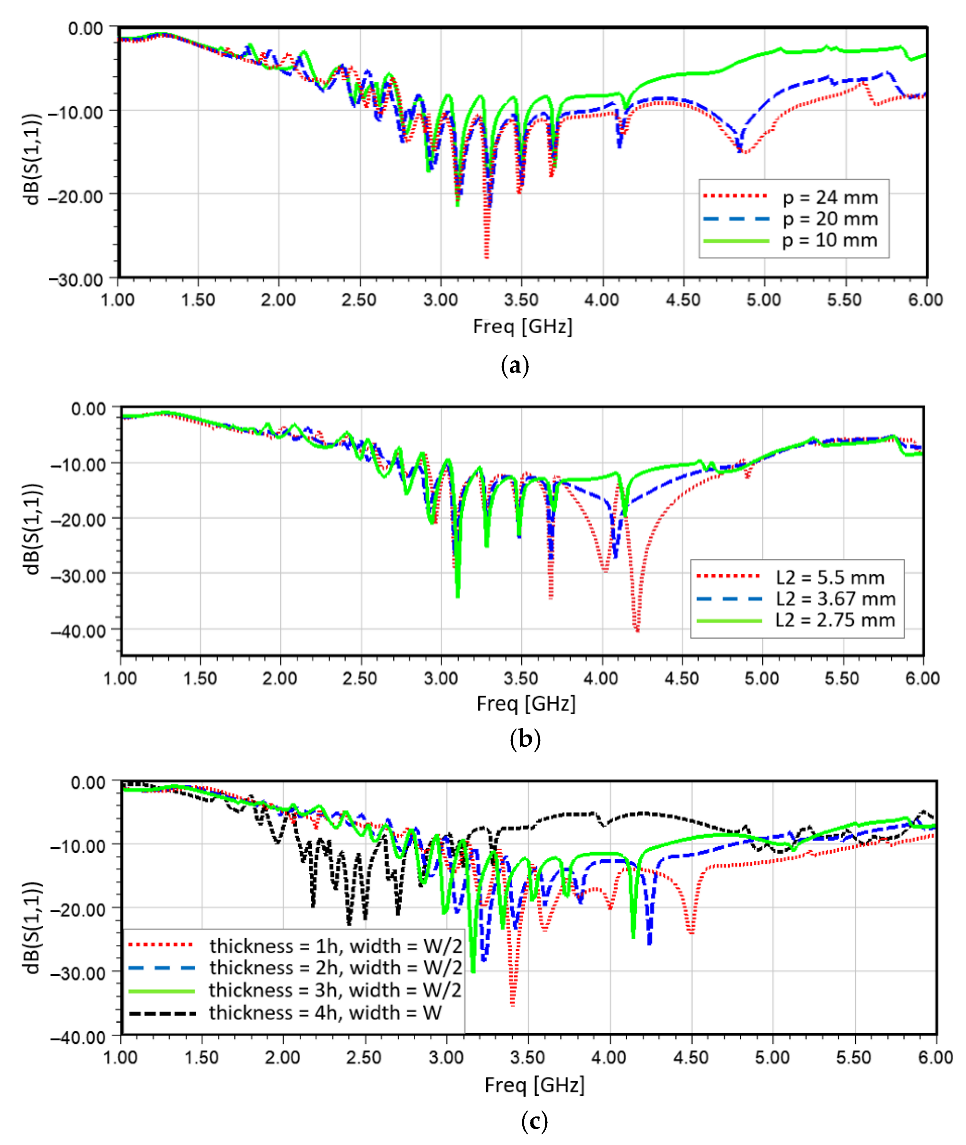
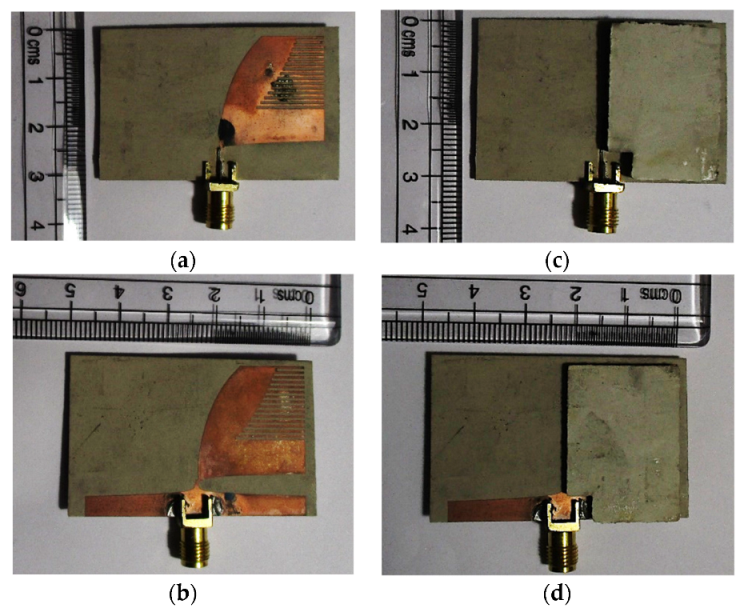


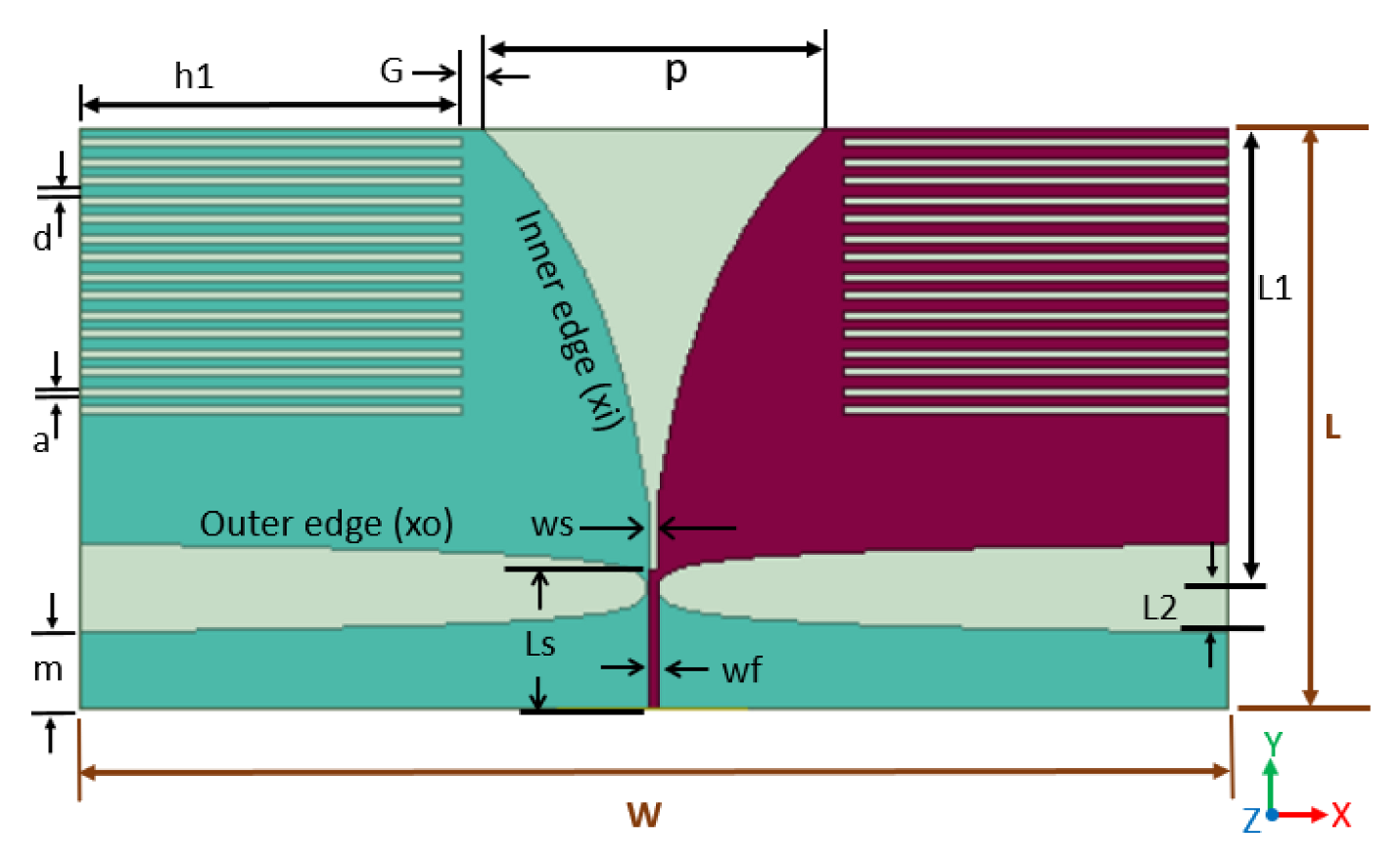
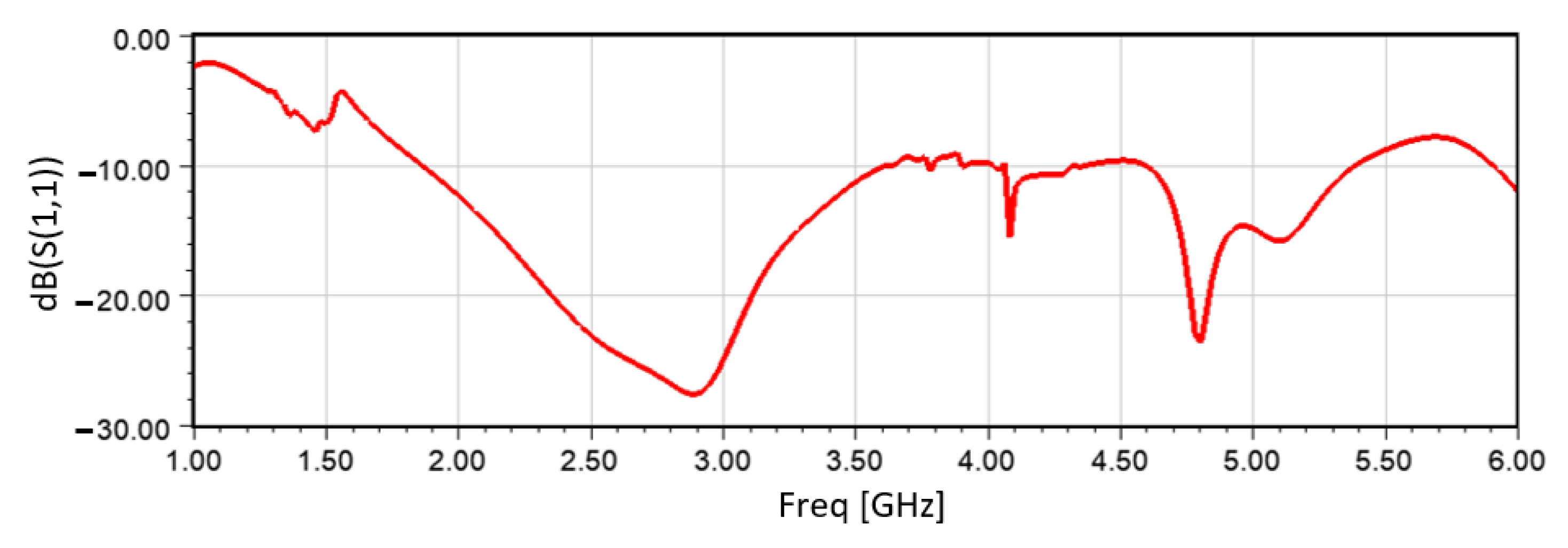
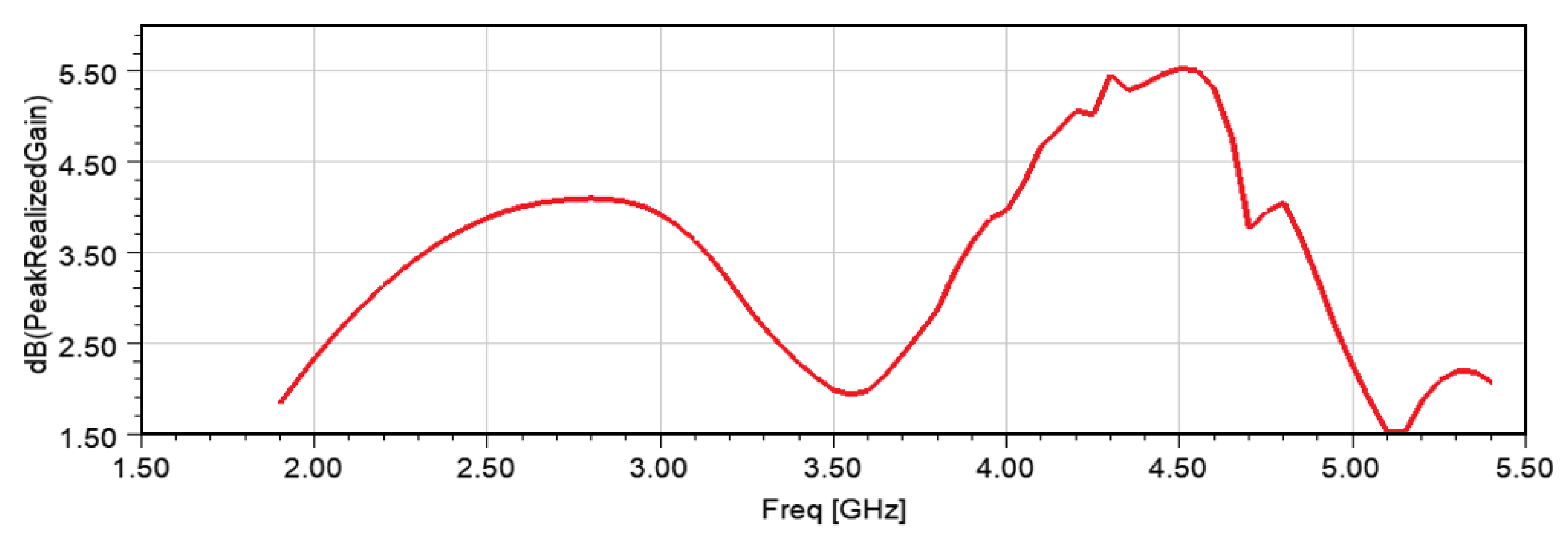
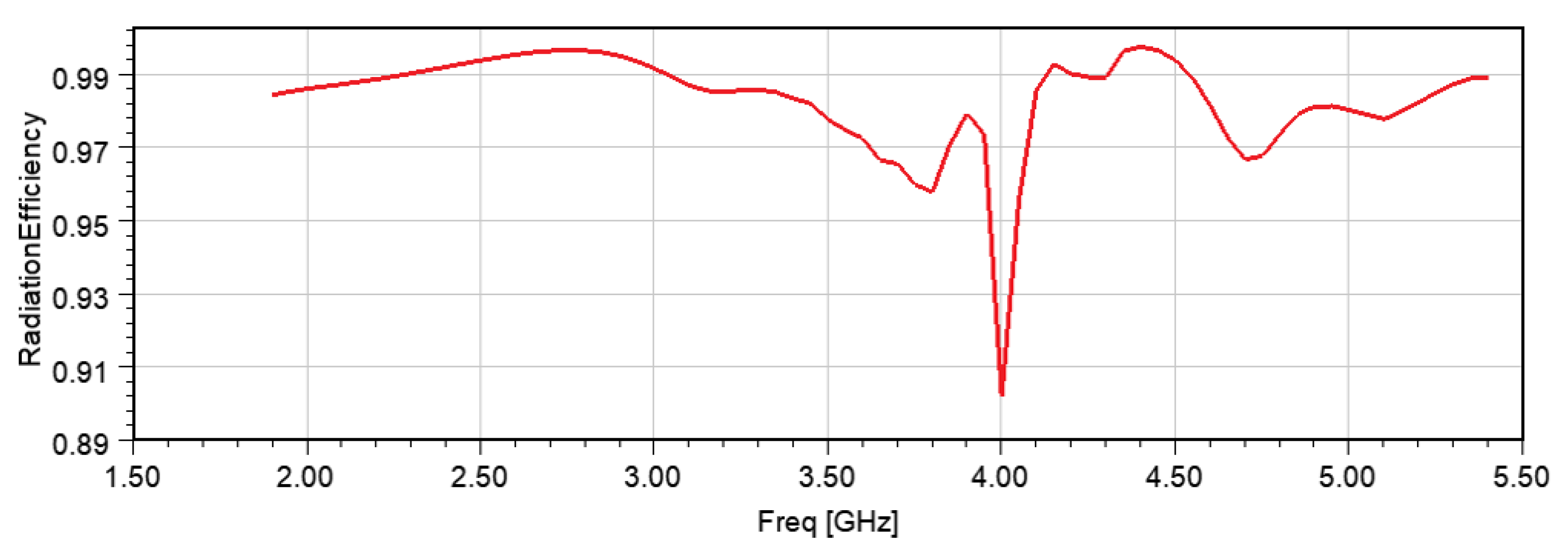

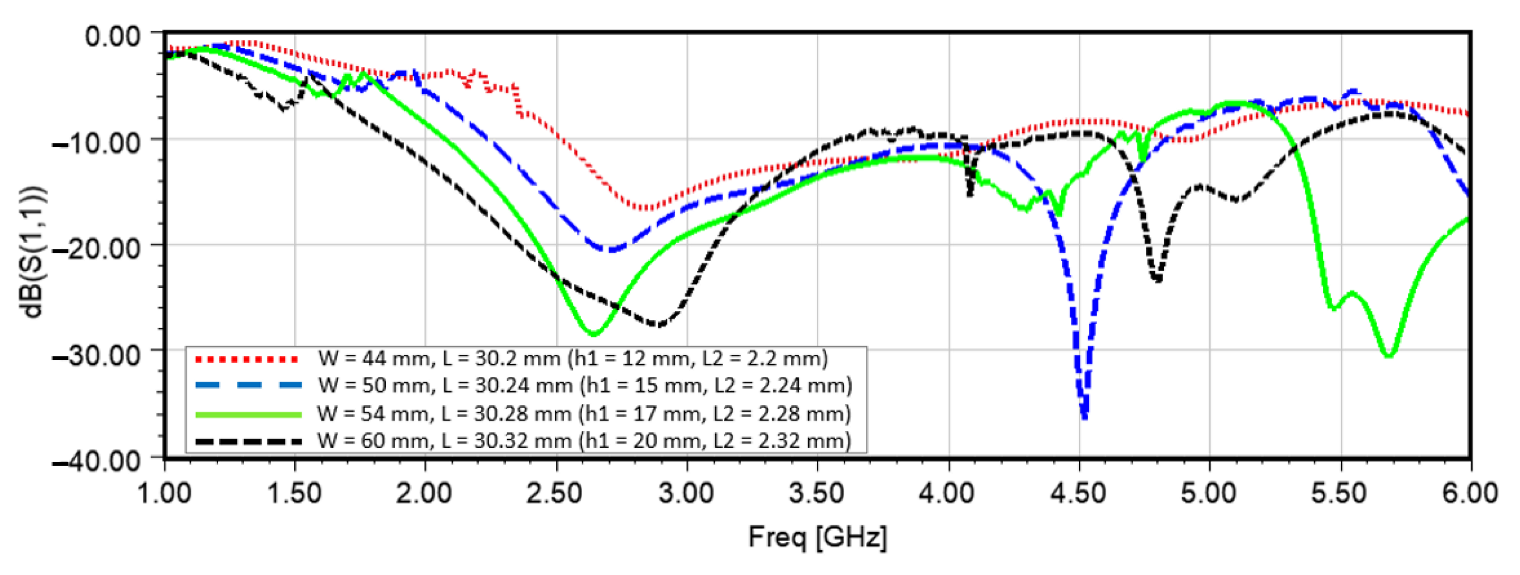
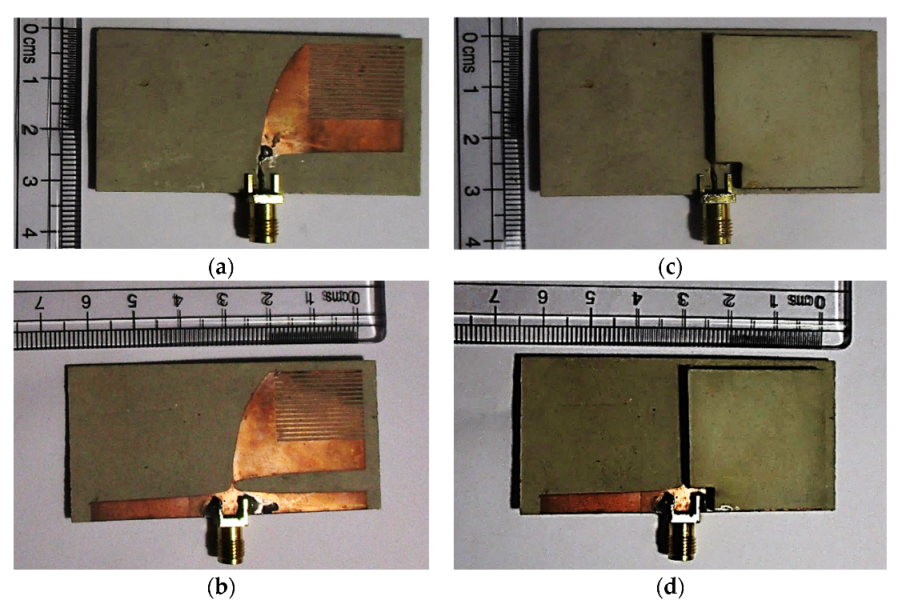
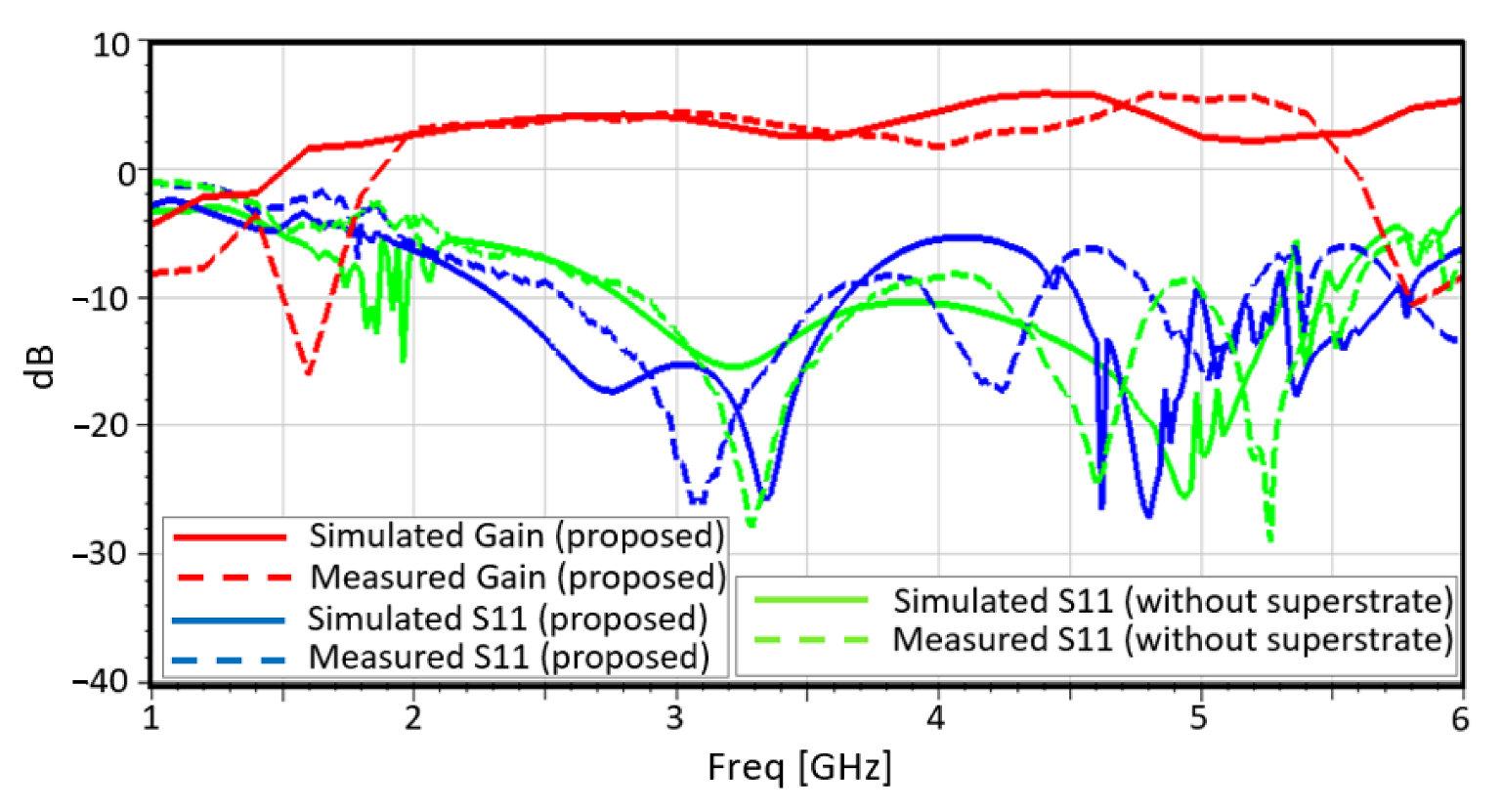
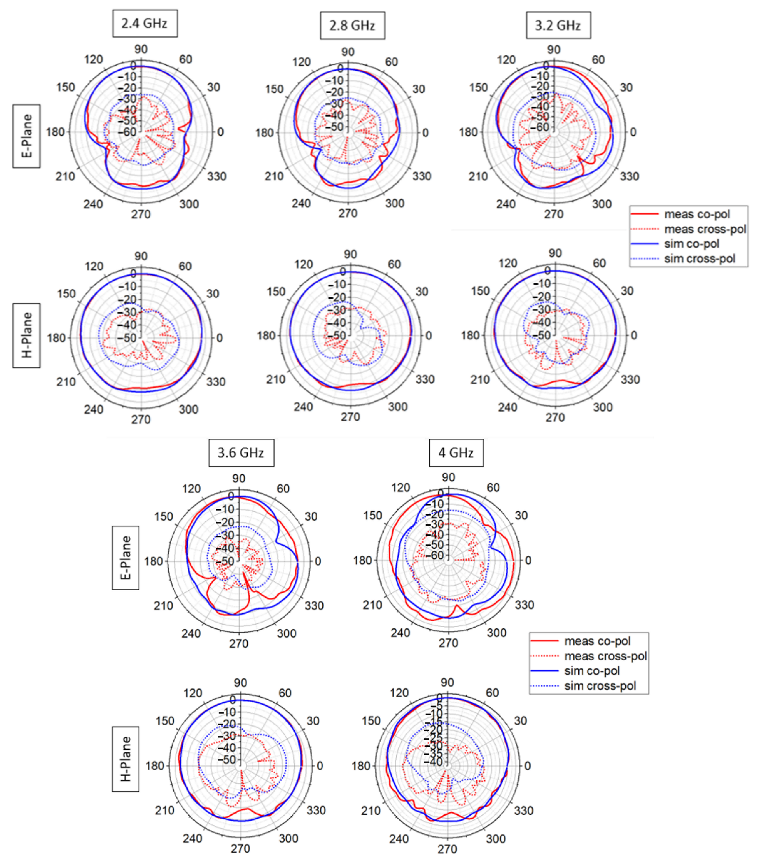
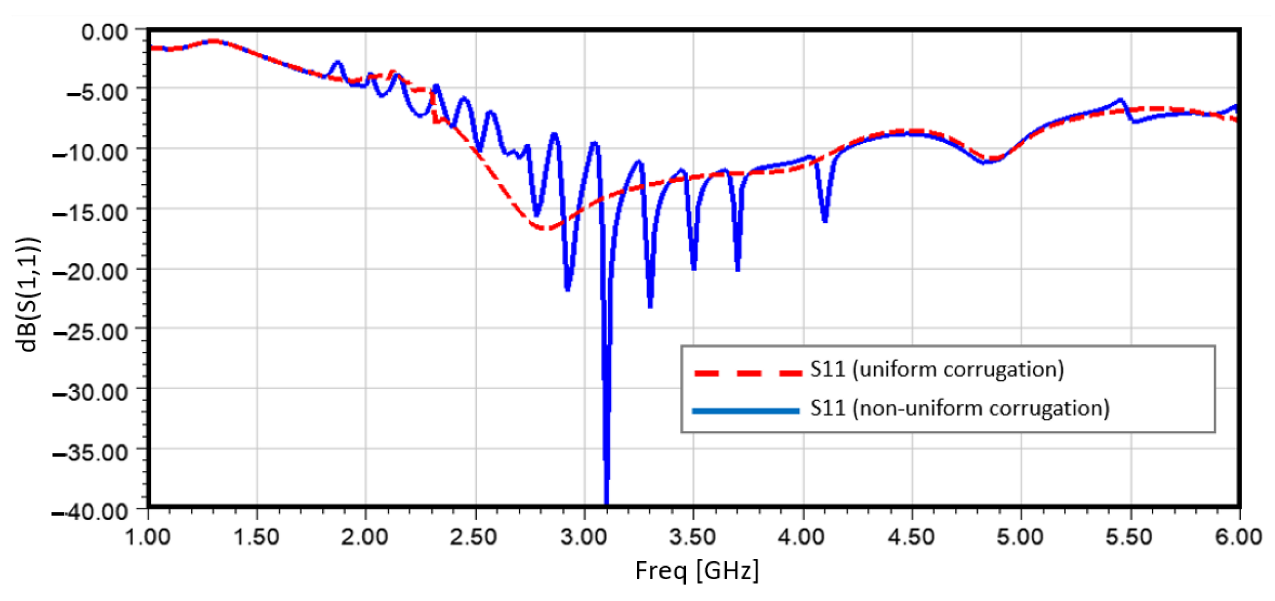
| [Reference] Substrate (ϵr) | Dimension (mm3) | Operating Frequency (GHz) | Matching Liquid? |
|---|---|---|---|
| [37] FR4 (4.3) | 100 × 100 × 1 | 1–5 | No |
| [38] Arlon AD (3.234) | 94 × 64 × 9.14 | 0.5–12 | Yes |
| [39] Rogers RO4350B (3.84) | 50 × 60 × 1.524 | 2.06–2.61 | No |
| [40] FR4 (4.3) | 75 × 90 | 1.6–15 | No |
| [17] Rogers RT6010 (10.2) | 22 × 40 | 2.7–11 | Yes |
| [23] Rogers RT6010 (10.2) | 25 × 30 | 1.8–10.8 | No |
| [41] Rogers RO3010 (10.2) | 45 × 24 × 1.28 | 0.6–5 | Yes |
| [42] Rogers RO3010 (10.2) | 95 × 120 × 1.28 | 1.1–4 | No |
| [43] Rogers RT/duroid 6010 (10.2) | 60 × 60 × 1.905 | 0.5–5 | Yes |
| Proposed Antenna 1 Rogers RT/duroid 6010 (10.2) | 30.2 × 44.4 × 5.76 | 2.65–4.2 GHz | No |
| Proposed Antenna 2 Rogers RT/duroid 6010 (10.2) | 30.32 × 60 × 5.76 | 1.9–5.4 GHz | No |
Publisher’s Note: MDPI stays neutral with regard to jurisdictional claims in published maps and institutional affiliations. |
© 2022 by the authors. Licensee MDPI, Basel, Switzerland. This article is an open access article distributed under the terms and conditions of the Creative Commons Attribution (CC BY) license (https://creativecommons.org/licenses/by/4.0/).
Share and Cite
Parveen, F.; Wahid, P. Design of Miniaturized Antipodal Vivaldi Antennas for Wideband Microwave Imaging of the Head. Electronics 2022, 11, 2258. https://doi.org/10.3390/electronics11142258
Parveen F, Wahid P. Design of Miniaturized Antipodal Vivaldi Antennas for Wideband Microwave Imaging of the Head. Electronics. 2022; 11(14):2258. https://doi.org/10.3390/electronics11142258
Chicago/Turabian StyleParveen, Farhana, and Parveen Wahid. 2022. "Design of Miniaturized Antipodal Vivaldi Antennas for Wideband Microwave Imaging of the Head" Electronics 11, no. 14: 2258. https://doi.org/10.3390/electronics11142258
APA StyleParveen, F., & Wahid, P. (2022). Design of Miniaturized Antipodal Vivaldi Antennas for Wideband Microwave Imaging of the Head. Electronics, 11(14), 2258. https://doi.org/10.3390/electronics11142258





